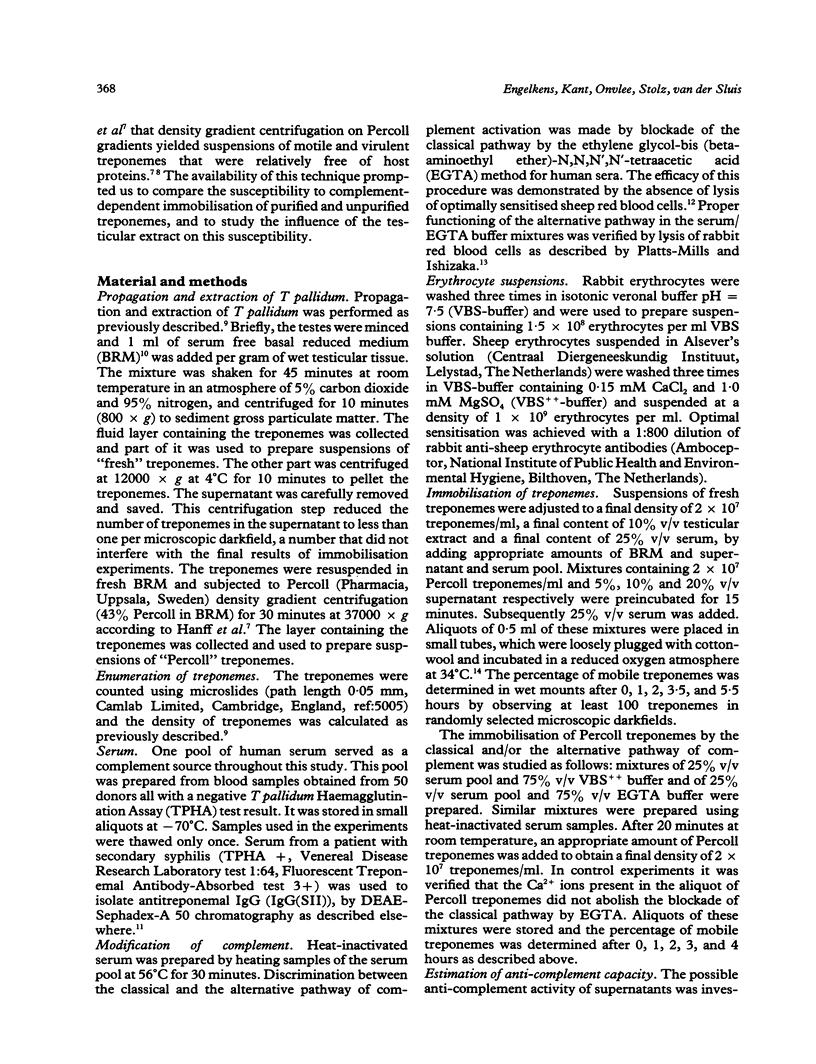Abstract
The use of Percoll-purified treponemes in an assay similar to the Treponema pallidum Immobilisation test demonstrated that immobilisation of purified treponemes by seronegative normal human serum proceeded at a much higher rate than that of unpurified treponemes. This suggests that the removal of the testicular extract makes the treponemes more vulnerable to this action. A preincubation of the purified treponemes with the testicular extract from infected or uninfected testes delayed their rate of immobilisation to that demonstrated by the unpurified treponemes. This showed that substances produced during the infection are probably not responsible for the delay in immobilisation. Discrimination between the classical and the alternative pathway of complement activation, studied by the ethylene glycol-bis (beta-aminoethyl ether) N,N,N',N'-tetraacetic acid (EGTA) method, showed that the classical pathway was responsible for the rapid immobilisation of the purified treponemes. However, the slow immobilisation in the EGTA-serum samples suggested a minor role of the alternative pathway in the immobilisation of the purified treponemes. Since the testicular extracts exerted an anti-complement activity, it needs to be investigated whether the protection offered to the purified treponemes by the testicular extracts is based on their deteriorating effect on the classical complement pathway or is due to a re-establishment of the protective cover around the treponemes.
Full text
PDF






Images in this article
Selected References
These references are in PubMed. This may not be the complete list of references from this article.
- Alderete J. F., Baseman J. B. Serum lipoprotein binding by Treponema pallidum: possible role for proteoglycans. Genitourin Med. 1989 Jun;65(3):177–182. doi: 10.1136/sti.65.3.177. [DOI] [PMC free article] [PubMed] [Google Scholar]
- Alderete J. F., Baseman J. B. Surface-associated host proteins on virulent Treponema pallidum. Infect Immun. 1979 Dec;26(3):1048–1056. doi: 10.1128/iai.26.3.1048-1056.1979. [DOI] [PMC free article] [PubMed] [Google Scholar]
- Bailey M. J., Cockayne A., Penn C. W. Monoclonal antibodies directed against surface-associated polypeptides of Treponema pallidum define a biologically active antigen. J Gen Microbiol. 1987 Jul;133(7):1793–1803. doi: 10.1099/00221287-133-7-1793. [DOI] [PubMed] [Google Scholar]
- Bailey M. J., Cockayne A., Penn C. W. Production of murine monoclonal antibodies to the major axial filament polypeptide of Treponema pallidum. J Gen Microbiol. 1987 Jul;133(7):1805–1813. doi: 10.1099/00221287-133-7-1805. [DOI] [PubMed] [Google Scholar]
- Baughn R. E. Antibody-independent interactions of fibronectin, C1q, and human neutrophils with Treponema pallidum. Infect Immun. 1986 Nov;54(2):456–464. doi: 10.1128/iai.54.2.456-464.1986. [DOI] [PMC free article] [PubMed] [Google Scholar]
- Blanco D. R., Radolf J. D., Lovett M. A., Miller J. N. Correlation of treponemicidal activity in normal human serum with the presence of IgG antibody directed against polypeptides of Treponema phagedenis biotype Reiter and Treponema pallidum, Nichols strain. J Immunol. 1986 Sep 15;137(6):2031–2036. [PubMed] [Google Scholar]
- CHRISTIANSEN S. Protective layer covering pathogenic treponemata. Lancet. 1963 Feb 23;1(7278):423–425. doi: 10.1016/s0140-6736(63)92309-2. [DOI] [PubMed] [Google Scholar]
- Fieldsteel A. H., Cox D. L., Moeckli R. A. Cultivation of virulent Treponema pallidum in tissue culture. Infect Immun. 1981 May;32(2):908–915. doi: 10.1128/iai.32.2.908-915.1981. [DOI] [PMC free article] [PubMed] [Google Scholar]
- Fitzgerald T. J. Activation of the classical and alternative pathways of complement by Treponema pallidum subsp. pallidum and Treponema vincentii. Infect Immun. 1987 Sep;55(9):2066–2073. doi: 10.1128/iai.55.9.2066-2073.1987. [DOI] [PMC free article] [PubMed] [Google Scholar]
- Fitzgerald T. J., Johnson R. C. Surface mucopolysaccharides of Treponema pallidum. Infect Immun. 1979 Apr;24(1):244–251. doi: 10.1128/iai.24.1.244-251.1979. [DOI] [PMC free article] [PubMed] [Google Scholar]
- Fitzgerald T. J. Pathogenesis and immunology of Treponema pallidum. Annu Rev Microbiol. 1981;35:29–54. doi: 10.1146/annurev.mi.35.100181.000333. [DOI] [PubMed] [Google Scholar]
- Hanff P. A., Norris S. J., Lovett M. A., Miller J. N. Purification of Treponema pallidum, Nichols strain, by Percoll density gradient centrifugation. Sex Transm Dis. 1984 Oct-Dec;11(4):275–286. doi: 10.1097/00007435-198410000-00003. [DOI] [PubMed] [Google Scholar]
- Platts-Mills T. A., Ishizaka K. Activation of the alternate pathway of human complements by rabbit cells. J Immunol. 1974 Jul;113(1):348–358. [PubMed] [Google Scholar]
- Radolf J. D., Norgard M. V., Schulz W. W. Outer membrane ultrastructure explains the limited antigenicity of virulent Treponema pallidum. Proc Natl Acad Sci U S A. 1989 Mar;86(6):2051–2055. doi: 10.1073/pnas.86.6.2051. [DOI] [PMC free article] [PubMed] [Google Scholar]
- Zeigler J. A., Jones A. M., Jones R. H., Kubica K. M. Demonstration of extracellular material at the surface of pathogenic T. pallidum cells. Br J Vener Dis. 1976 Feb;52(1):1–8. doi: 10.1136/sti.52.1.1. [DOI] [PMC free article] [PubMed] [Google Scholar]
- van der Sluis J. J., Kant M., Onvlee P. C., Stolz E. The inaccessibility of the outer membrane of adherent Treponema pallidum (Nichols strain) to anti-treponemal antibodies, a possible role of serum proteins. Genitourin Med. 1990 Jun;66(3):165–170. doi: 10.1136/sti.66.3.165. [DOI] [PMC free article] [PubMed] [Google Scholar]
- van der Sluis J. J., Koehorst J. A., Boer A. M. Factors that inhibit adherence of Treponema pallidum (Nichols strain) to a human fibroblastic cell line: development in serum of patients with syphilis. Genitourin Med. 1987 Apr;63(2):71–76. doi: 10.1136/sti.63.2.71. [DOI] [PMC free article] [PubMed] [Google Scholar]
- van der Sluis J. J., van Dijk G., Boer M., Stolz E., van Joost T. Mucopolysaccharides in suspensions of Treponema pallidum extracted from infected rabbit testes. Genitourin Med. 1985 Feb;61(1):7–12. doi: 10.1136/sti.61.1.7. [DOI] [PMC free article] [PubMed] [Google Scholar]
- van der Sluis J. J., van Reede E. C., Boer M. Immunoglobulin G subclasses of fluorescent anti-Treponema pallidum antibodies: evidence for sequential development of specific anti-T. pallidum immunoglobulin G responses in patients with early syphilis. J Clin Microbiol. 1986 Sep;24(3):418–423. doi: 10.1128/jcm.24.3.418-423.1986. [DOI] [PMC free article] [PubMed] [Google Scholar]



